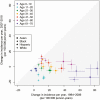Herpes Zoster and Postherpetic Neuralgia: Changing Incidence Rates From 1994 to 2018 in the United States
- PMID: 32829399
- PMCID: PMC8563174
- DOI: 10.1093/cid/ciaa1185
Herpes Zoster and Postherpetic Neuralgia: Changing Incidence Rates From 1994 to 2018 in the United States
Abstract
Background: The incidence of herpes zoster (HZ) has been increasing in recent decades. Although 2 vaccines for HZ are available, there have been few studies on the incidence rates of HZ and postherpetic neuralgia (PHN) since their introduction. This study examined the incidence rates of HZ and PHN from 1994 to 2018 in the United States to determine if they have continued to increase since introduction of the HZ vaccines.
Methods: A de-identified longitudinal administrative claims database, the OptumLabs Data Warehouse, was used to assess incidence rates among individuals continuously enrolled in the database for ≥365 days with no prior history of HZ or PHN. Unstandardized and standardized incidence rates were calculated by year, 10-year age groups, sex, and race/ethnicity.
Results: There were 610 766 individuals with HZ (median age, 56.3; interquartile range, 43.0-68.7 years; 59.8% women; 70.6% white). From 1994 to 2018, the incidence of HZ increased from 286.0 (95% confidence interval [CI], 259.1-312.8) to 579.6 (95% CI, 554.2-605.0) cases per 100 000 person-years, an annual increase of 3.1% (95% CI, 2.5-3.6%). Since 2007, annual HZ incidence rates have decreased in individuals ≤20 and >60 years old. The overall incidence rate of PHN was 57.5 (95% CI, 56.0-59.0) cases per 100 000 person-years. The proportion of individuals with HZ who developed PHN was higher from 2007 to 2018 than from 1994 to 2006.
Conclusions: HZ incidence rates have continued to increase in age groups for which HZ vaccines are not currently recommended, warranting a review of current vaccine recommendations.
Keywords: epidemiology; herpes zoster; infectious disease; postherpetic neuralgia; varicella zoster virus.
© The Author(s) 2020. Published by Oxford University Press for the Infectious Diseases Society of America. All rights reserved. For permissions, e-mail: journals.permissions@oup.com.
Figures




Comment in
-
Commentary on Herpes Zoster and Postherpetic Neuralgia.Clin Infect Dis. 2021 Nov 2;73(9):e3218-e3219. doi: 10.1093/cid/ciaa1192. Clin Infect Dis. 2021. PMID: 32829389 No abstract available.
References
-
- Lal H, Cunningham AL, Godeaux O, et al. ; ZOE-50 Study Group . Efficacy of an adjuvanted herpes zoster subunit vaccine in older adults. N Engl J Med 2015; 372:2087–96. - PubMed
-
- Leung J, Harpaz R, Molinari NA, Jumaan A, Zhou F. Herpes zoster incidence among insured persons in the united states, 1993–2006: evaluation of impact of varicella vaccination. Clin Infect Dis 2011; 52:332–40. - PubMed
-
- Harpaz R, Ortega-Sanchez IR, Seward JF. Prevention of herpes zoster: recommendations of the Advisory Committee on Immunization Practices (ACIP). MMWR Recomm Rep 2008; 57:1–30. - PubMed
-
- Schutzer-Weissmann J, Farquhar-Smith P. Post-herpetic neuralgia—a review of current management and future directions. Expert Opin Pharmacother 2017; 18:1739–50. - PubMed

